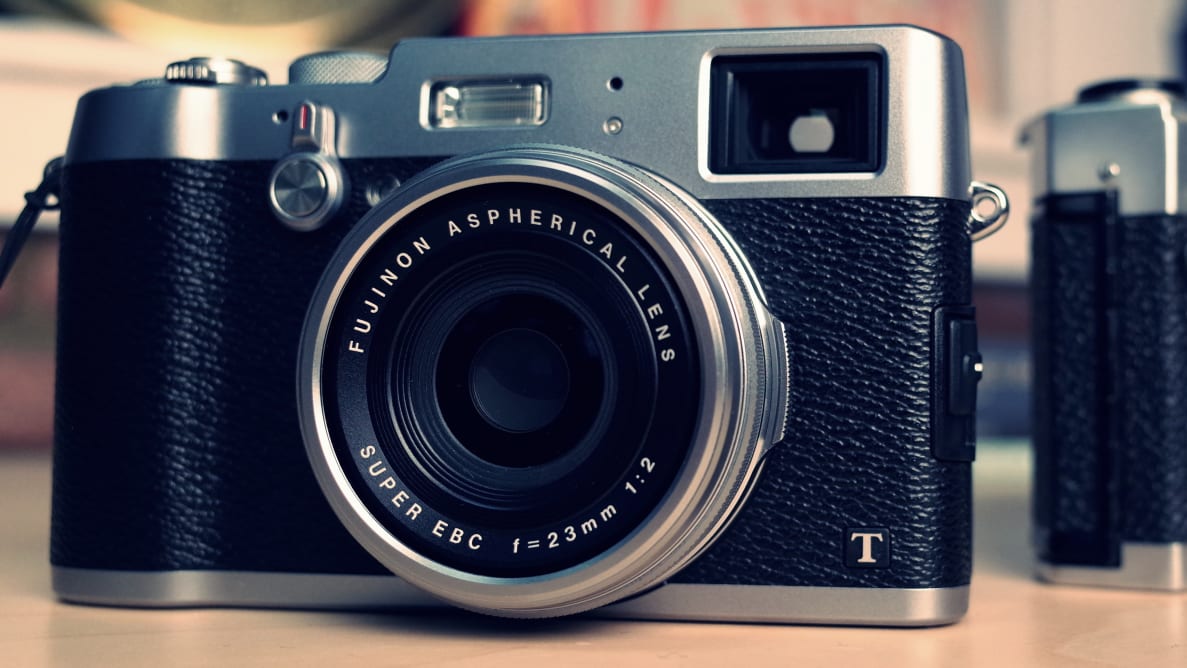The humble camera that started it all (again) for Fujifilm was based on a simple enough premise. By mixing a DSLR-sized sensor, a unique optical/electronic viewfinder, and a fixed-focal, 23mm f/2 lens, it already had a lot going for it on specs alone. By wrapping the X100 in a drop-dead gorgeous classic rangefinder look, Fujifilm pushed the concept over the top.
Even though you could confuse the brand-new X100T (MSRP $1,299.95) for either the original X100 or last year's X100S, it's actually the deepest revision the product has seen since 2011.
In the ensuing years, the X100T has benefitted from those earlier, more flawed X100 models. It's learned to become a sharper, nimbler take on a charming concept. Packing the best hybrid viewfinder yet, and refined controls, this is the potential we all saw inside that original X100, finally come to life and on the shelf of an e-tailer or camera store near you.
{{brightcove '3792013499001'}}
Design & Handling
The devil is in the details.
Although it's known for its unabashed retro style, the X100T isn't just an impostor in a neat costume. The metal finish, notchy knobs, and leatherette all feel like they could have come straight from the 1970s. Love it or loathe it, the camera series that started the current retro camera design influx is at it again, and simply sanding down the remaining rough edges to make a finished product that feels better than ever. The X100 and X100S, while certainly successful first efforts, still felt a bit clunky to operate. The X100T deals with the pain points and keeps what works while replacing what didn't the first two times around.
{{ photo_gallery "tour" }}
As a neo-icon of digital photography, the X100 is quickly becoming like the Porsche 911 of the camera world. Year over year, this classically styled camera has gained performance bumps through hardware and software changes. The average Jane would be hard-pressed to tell the X100T from any of the other X100 models, simply because it carries forward the same general outline. To our eye, though, the X100T really cleans up the design of the X100, making it less fussy while still keeping it distinctive.
While the general placement of controls is very similar, the different buttons and dials you'll find on the X100T really improve the overall shooting experience. X100 and X100S owners, pop a cork and toast the passing of that annoyingly vague-feeling, wobbly rear control dial! The X100T replaces that control with a simple, responsive d-pad that's pleasingly raised from the camera's body. Not only are these useful for navigating menus, but all four directions are now customizable function buttons.
We loved the addition of the Q menu in the X20 and X100S, and the Q button now gets a spot on the back of the X100T that makes it easy to press from the d-pad—just move your thumb a quarter of an inch up and to the left, and you're there. In a very small space, you can hit up most of the camera's major functions and settings, even with your face pressed up against the viewfinder.
Between the EV comp dial (which now has ±3 EV), the improved aperture ring (which gives you two selections between the major stops), the shutter dial, and the power switch surrounding the very nice feeling shutter button, the X100T now gives us very little to complain about. The only control that still feels lackluster is the horizontal control dial that replaces the old rocker of X100s past. The wheel itself is plastic, and it doesn't have much of a feel to it. It's really too bad, since just about every other rotating control on the camera is nice and notchy, putting up a satisfying amount of resistance and giving you the right amount of feedback each time.
{{ photo_gallery "design" }}
The bottom of the camera is where you'll find the battery and the SD card slot. In case you're wondering, yes, the battery can still be inserted the "wrong" way. Follow the orange stripe and you won't mess up, but if you put the battery back into the camera incorrectly, you'll know right away—it won't turn on. All the I/O is neatly tucked away under one flap, with a new mic/remote jack, micro USB, and micro HDMI in a row. A neat new feature of the X100T is that you can now charge via USB, so you can take one less charger with you on vacation, to use a battery backup for extra juice. Finally, the rear LCD is bigger at 3 inches diagonal, and it's even sharper to boot (1040 k-dots, up from a measly 460k).
As a high-end compact, you couldn't ask for much more. Advanced controls, pleasing materials, and a design that will melt your heart just a bit every time you pick it up.
Features
The improved viewfinder makes the camera.
When comparing the X100T to other enthusiast-oriented compact cameras, you'll find that it has a lot in common with the competition. While it isn't as diminutive as the Nikon Coolpix A or the Ricoh GR, Fujifilm's spiritual flagship features a fast 23mm f/2 lens and a 16-megapixel APS-C sized sensor with the company's unique X-trans technology. It's basically the same imaging package we saw in the X100S, but it continues to create incredible photos. While the lens isn't tack-sharp wide open, f/2 has a soft, dreamy allure that gives shots character. Stop it down to f/2.8 and you can get beautiful bokeh along with nicely sharp in-focus elements. The X100's leaf shutter keeps the camera incredibly quiet, while the new electronic shutter reaches speeds up to 1/32,000, so you can shoot with the aperture as wide as you want, no matter how bright it is outside. Add an built-in ND filter into the mix and you'll get all the bokeh you want all summer long.
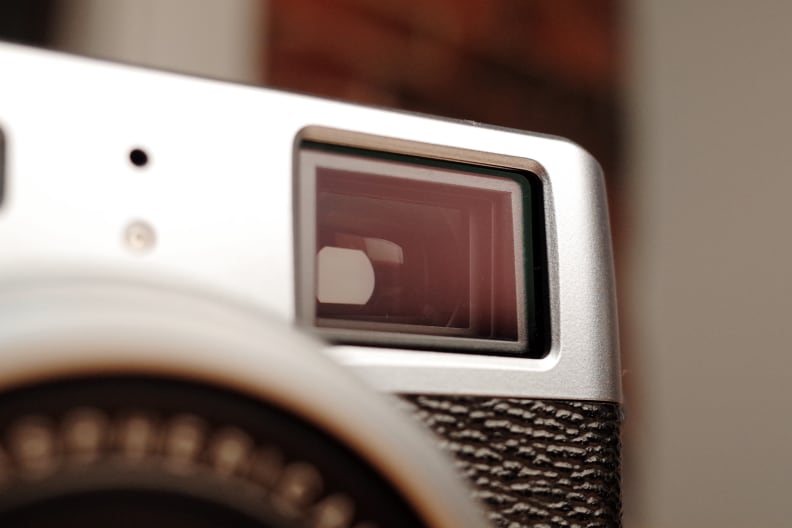
The hybrid viewfinder is better in a couple ways.
Additionally, as a part of a system of sorts, if the 35mm equivalent focal length isn't your cup of tea, Fuji offers two conversion lenses—one to make it 28mm equivalent, and another to transform it into a 50mm equivalent if that's your preferred field of view.
While the sensor and lens are a tremendous draw for the X100T, we were again pleased to see some meaningful change to a feature the camera is best known for—Fujifilm's hybrid viewfinder. While it's always been a treat to use, the X100T gets some changes that really help make the optical portion of the finder shine, while the new OLED panel used for the digital portion is sharper and faster to refresh. The concept gives you the best of an all-digital electronic view while also letting you use a bright optical finder with a digital overlay, giving you an idea of framing and all the vital shooting information you might need.
Moreover, the software will change the frame guidelines depending on where the camera's focused, so that you can better account for more severe parallax error. And, redesigning all the necessary optical elements, there was just enough extra space left inside the camera to build in an extendable ND filter into the finder. The camera can project a tiny window of live view onto the ND filter, giving you a small portion of the middle of the frame. The practical benefit is that you can get an idea of what the film simulation looks like, while using the camera's focus assist tools all inside of the bright, clear optical finder.
Fujifilm has also beefed up the WiFi features in this X100T. Instead of just having the option of using an EyeFi card, the X100T has WiFi fully integrated and it's compatible with iOS and Android smartphones. Moreover, you can now print photos from the X100T directly to Fujifilm's fun little Instax Share printer. In mere seconds, you can take any photo taken with the X100T and have it pop up on real instant film, and the results are better than they deserve to be.
Performance
Befitting an advanced compact.
Since little has changed in terms of the lens and sensor combination, we weren't shocked to find that the Fujifilm X100T performed pretty darn well. It's a tiny bit better than the X100S in many regards, but in others it remains, shall we say, not without its quirks.
{{ photo_gallery "sample-photo" }}
Fujifilm's autofocus performance continues to improve here and there, and preserving the significant gains made in the X100S, this iteration manages to feel fresh and snappy. We only experienced AF problems when trying to focus on objects that were extremely thin, like the stem of a plant. That's funny since the on-sensor phase detection should kick in and assist but, we found them to be of little help when using single-point AF.
Continuous AF, on the other hand, obviously benefits from the phase detection, and the camera is reasonably quick in this mode. While it won't replace a DSLR any time soon for action photography, the X100T might just be the quickest-focusing enthusiast compact. Metering is reliable enough, but we found center-weighted metering to be a bit fussy at times, tending to underexpose shots. Even so, we were very impressed with the camera's ability to accurately meter scenes with the full multi mode turned on.
In our labs, stills turned out sharp, the highly customizable noise reduction is applied evenly, and colors look great thanks to a number of film simulation modes. Where the X100T (and Fujifilm's X-trans sensors in general) still fall totally short of the competition is when it comes to HD video.

Even though we've heard that Fujifilm intends to make video a high priority, the X100T shows no evidence of bearing the fruits of that labor. Footage we recorded in the lab lacked sharpness, and, even worse, had terrible moiré with false color every which way but loose. We have to chalk it up to the uniqueness of the X-trans sensor's color filter array. We hold out some hope that Fujifilm will get its act together, but the soft, poor-quality HD footage we saw is a disappointment. You now get 1080/60p as the camera's top recording mode, and there's a real microphone jack this time around. You can also shoot video using the optical finder only, which, if we're quite honest, is nothing more than a gimmick.

Thankfully, this isn't meant to be a camcorder. It's a stills camera first and foremost. We can say without much hesitation that the X100T will give you image quality that's at least as good as the X100S, if not just a hair better. The only quirk continues to be that ISO sensitivity range tops out at 6400 when you capture RAW files. Moreover, if you want to use the camera's electronic shutter, you can only go up to that same ISO, instead of getting the full range up to 51,200.
As long as you don't care about high-quality video, you'll be very pleased. For more information on how the Fujifilm X100T scored in our labs, click over to our science page.
Conclusion
A stunning camera, but one at a high price.
If you're an enthusiast with $1,200 to burn, who wants a camera that's a blast to shoot with, the X100T is tough to beat. It may cost a pretty penny, but it's a very capable compact camera that can produce gorgeous photos. Fujifilm has finally addressed the biggest, most glaring problems that held back its predecessors, leaving all the character and charm that caused us to fall in love with this camera line in the first place.
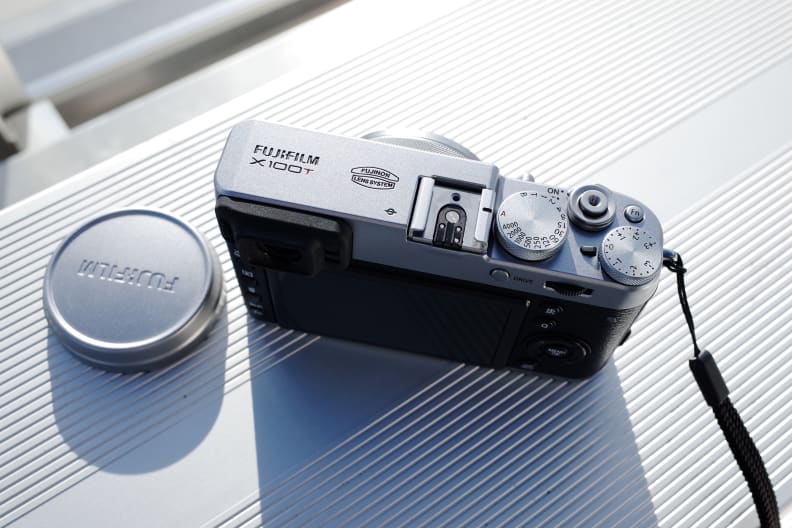
It might be pricey, but the X100T is a camera that is in a league of its own.
While we've championed the Ricoh GR in the past, that camera is actually quite different from the X100T. Nikon's similarly specced APS-C compact, the Coolpix A, finally dropped in price to match the Ricoh at around $700. Those two cameras are significantly cheaper and both more compact and you can't go too wrong with either.
But, you'll miss out on the amazing hybrid viewfinder that Fujifilm has pulled off so well in the X100T. We're not saying that the viewfinder is worth $600, but if you prefer to look through a finder rather than at an LCD, the X100T fits the bill. We even like this shooting experience better than many DSLRs, since you get the information you need, smart framelines, with a full digital mode, too. The camera will even give you an image preview by popping the OLED digital panel into view for a second, which, if you pardon the hyperbole for just a second, is some flippin' wizardry.
When it comes right down to it, I'd gladly choose the Ricoh for surreptitious street photography. That camera is a sneaky little devil, that's easy to control one-handed and that catches fleeting moments without raising suspicion (and, if you're brave, even fits in a pants pocket).
The Fujifilm X100T is the polar opposite. Its controls encourage you to stop, look around, and use both hands to grab what you're envisioning. The camera reminds you to savor the process.
Such a great shooting experience is rarely worth quantifying with a dollar amount (ask a Leica fan), but nevertheless, the X100T continues to be a singular camera. It's premium photographic bliss, made in Japan.
By the Numbers
Fujifilm has established itself as a very capable imaging company in the last few years, and the X100T reflects that extremely well. It comes jam-packed with everything we've come to expect from the company. We've honored the X100T with our editors' choice not just because it's a unique camera—you can expect potent performance from it in most areas we test.
Color & White Balance
Fujifilm has taken its past in film and applied it liberally to the way that cameras like the X100T interpret colors. If you shoot JPEG for whatever reason (no judgement—sometimes it's more convenient), the film simulation modes you can choose are just excellent. We had a ball with the brand-new Classic Chrome, and old favorites like Velvia, Provia, and Astia are all along for the ride too.
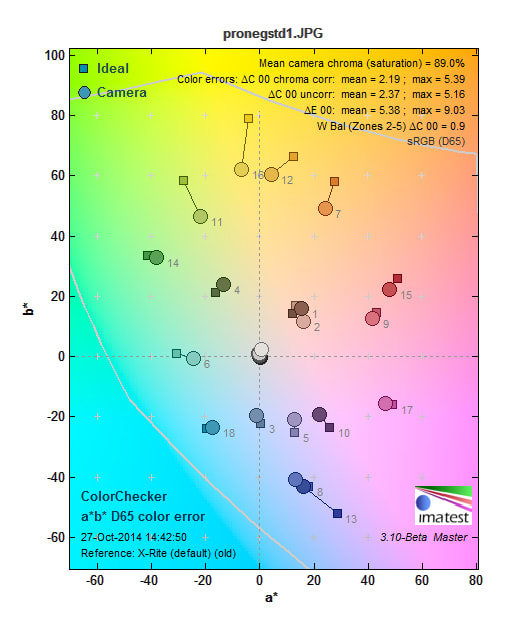
In the lab, the X100T's Pro Neg High mode was the most accurate. With Imatest, we measured a nearly spot-on saturation of 99.6% and a ∆00 uncorrected mean color error of only 2.17. That's darn good.
It's clear that the X100T's weak suit has to do with its white balance. It's a big improvement over the X100S, but still falls short of the more accurate cameras to grace our labs. In the especially difficult incandescent light test, we noticed a very bad red cast with Imatest reporting errors of up to -2300K in some cases. In manual mode, we saw some solid numbers with all lighting scenarios looking very natural.
Resolution
We'll be brief here: the lens on the X100T appears to be the exact same optical formula as previous X100 cameras. That means it's a 23mm (35mm on a 35mm camera) f/2 lens that's soft when wide open. Stop it down to f/2.8 for the best results, giving you both sharp in-focus objects, and nice subject isolation. Shooting at f/2 isn't bad, but it can lend a dreamy, creamy look to photos.
In our lab, we noticed that the X100T applies liberal amounts of sharpening to compensate for the lens's soft corners when shot at f/2. Given the fact that it's a single focal length, it's a reliably good lens that yielded numbers that are excellent from f/2.8 to f/5.6. TL;DR...the X100's lens continues to be worthy of the Fujinon branding it carries.
Video
Are you ready for the only real bit of bad news? Alright, here it is. The Fujifilm X100T is terrible at shooting video. We had heard that Fujifilm was taking HD shooting seriously since it was a hotly demanded feature from owners, but, here we are, writing about more awful moiré and more false color than you can shake a stick at. Moreover, the binning software Fujifilm is using makes video softer than we've seen from competing cameras.
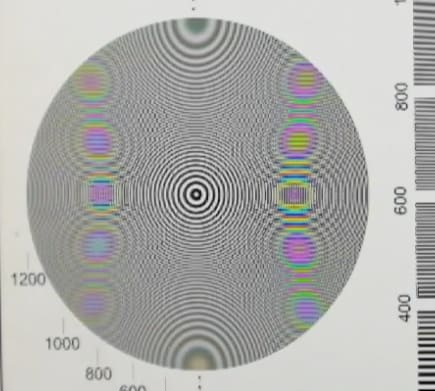
There's a whole lot more moiré where this came from.
In bright light, the X100T was able to resolve 500 line widths per picture height (lw/ph) horizontal and 600 lw/ph vertical. In our low-light scenario, we saw some falloff all the way to 425 lw/ph horizontal and 525 lw/ph vertical. Our review sample X100T needed 15 lux in order to make an image at 50 IRE, which is a standard for minimum brightness.
Noise
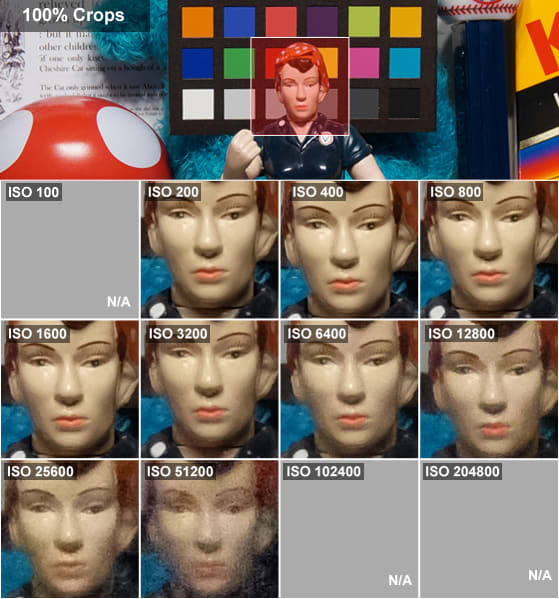
The X100T handles noise pretty well by default. Noise is controlled pretty well up to the maximum ISO in JPEG, which is 51,200. Of course, you won't want to use sensitivities that high with this camera. By our estimation, with default noise reduction on, the camera will start to obliterate fine detail at the higher ISOs. In the lab, we didn't cross the 2% noise barrier until max ISO, so that's saying something.
Thankfully, the X100T gives you as much control over the noise reduction and sensitivities. There are three programmable auto ISO options so you can keep one for sunny days, and another for more extreme cases. As it stands, for normal shooting, keep the X100T to ISO 800 and below for the absolute best results. Remember that the camera does have an ISO 100 level, but it's actually a simulated sensitivity, and we don't recommend using it.
Meet the tester
Brendan is originally from California. Prior to writing for Reviewed.com, he graduated from UC Santa Cruz and did IT support and wrote for a technology blog in the mythical Silicon Valley. Brendan enjoys history, Marx Brothers films, Vietnamese food, cars, and laughing loudly.
Checking our work.
Our team is here to help you buy the best stuff and love what you own. Our writers, editors, and experts obsess over the products we cover to make sure you're confident and satisfied. Have a different opinion about something we recommend? Email us and we'll compare notes.
Shoot us an email

